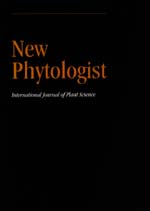Crossref Citations
This article has been cited by the following publications. This list is generated based on data provided by
Crossref.
Rafii, Zara A
and
Dodd, Richard S
1998.
Genetic diversity among Coastal and Andean natural populations of Araucaria araucana (Molina) K. Koch.
Biochemical Systematics and Ecology,
Vol. 26,
Issue. 4,
p.
441.
Afzal-Rafii, Zara
Dodd, Richard S.
and
Fauvel, Marie-Thérèse
1999.
Diversity and Function in Mangrove Ecosystems.
p.
1.
Dodd, Richard S
Blasco, François
Rafii, Zara A
and
Torquebiau, E
1999.
Mangroves of the United Arab Emirates: ecotypic diversity in cuticular waxes at the bioclimatic extreme.
Aquatic Botany,
Vol. 63,
Issue. 3-4,
p.
291.
Dodd, Richard S.
and
Afzal-Rafii, Zara
2000.
HABITAT-RELATED ADAPTIVE PROPERTIES OF PLANT CUTICULAR LIPIDS.
Evolution,
Vol. 54,
Issue. 4,
p.
1438.
Dodd, R. S.
Afzal‐Rafii, Z.
Kashani, N.
and
Budrick, J.
2002.
Land barriers and open oceans: effects on gene diversity and population structure in Avicennia germinans L. (Avicenniaceae).
Molecular Ecology,
Vol. 11,
Issue. 8,
p.
1327.
Calvo, Eva
Pelejero, Carles
Logan, Graham A.
and
De Deckker, Patrick
2004.
Dust‐induced changes in phytoplankton composition in the Tasman Sea during the last four glacial cycles.
Paleoceanography,
Vol. 19,
Issue. 2,
Shepherd, Tom
and
Wynne Griffiths, D.
2006.
The effects of stress on plant cuticular waxes.
New Phytologist,
Vol. 171,
Issue. 3,
p.
469.
Paula, Marchelli
and
Leonardo, Gallo
2006.
Multiple ice-age refugia in a southern beech of South America as evidenced by chloroplast DNA markers.
Conservation Genetics,
Vol. 7,
Issue. 4,
p.
591.
Bendle, James
Kawamura, Kimitaka
Yamazaki, Koji
and
Niwai, Takeji
2007.
Latitudinal distribution of terrestrial lipid biomarkers and n-alkane compound-specific stable carbon isotope ratios in the atmosphere over the western Pacific and Southern Ocean.
Geochimica et Cosmochimica Acta,
Vol. 71,
Issue. 24,
p.
5934.
Paull, Rosemary
and
Hill, Robert S.
2008.
Oligocene Austrocedrus from Tasmania (Australia): Comparisons with Austrocedrus chilensis.
International Journal of Plant Sciences,
Vol. 169,
Issue. 2,
p.
315.
Baquedano, Francisco J.
Valladares, Fernando
and
Castillo, Federico J.
2008.
Phenotypic plasticity blurs ecotypic divergence in the response of Quercus coccifera and Pinus halepensis to water stress.
European Journal of Forest Research,
Vol. 127,
Issue. 6,
p.
495.
Vogts, Angela
Moossen, Heiko
Rommerskirchen, Florian
and
Rullkötter, Jürgen
2009.
Distribution patterns and stable carbon isotopic composition of alkanes and alkan-1-ols from plant waxes of African rain forest and savanna C3 species.
Organic Geochemistry,
Vol. 40,
Issue. 10,
p.
1037.
Nikolic, Biljana
Tesevic, Vele
Djordjevic, Iris
Jadranin, Milka
Todosijevic, Marina
Bojovic, Srdjan
and
Marin, Petar
2010.
n-alkanes in needle waxes of Pinus heldreichii var. pancici.
Journal of the Serbian Chemical Society,
Vol. 75,
Issue. 10,
p.
1337.
Horikawa, Keiji
Murayama, Masafumi
Minagawa, Masao
Kato, Yoshihisa
and
Sagawa, Takuya
2010.
Latitudinal and Downcore (0–750 ka) Changes in Nalkane Chain Lengths in the Eastern Equatorial Pacific.
Quaternary Research,
Vol. 73,
Issue. 3,
p.
573.
Zheng, Yanhong
Zhou, Weijian
Liu, Zhao
and
Liu, Xiaomin
2011.
The n-alkanol paleoclimate records in two peat deposits: a comparative study of the northeastern margin of the Tibetan Plateau and Northeast China.
Environmental Earth Sciences,
Vol. 63,
Issue. 1,
p.
135.
Nikolić, Biljana
Tešević, Vele
Đorđević, Iris
Todosijević, Marina
Jadranin, Milka
Bojović, Srdjan
and
Marin, Petar D.
2012.
Population Variability of Nonacosan‐10‐ol and n‐Alkanes in Needle Cuticular Waxes of Macedonian Pine (Pinus peuceGriseb.).
Chemistry & Biodiversity,
Vol. 9,
Issue. 6,
p.
1155.
Seki, Osamu
Harada, Naomi
Sato, Miyako
Kawamura, Kimitaka
Ijiri, Akira
and
Nakatsuka, Takeshi
2012.
Assessment for paleoclimatic utility of terrestrial biomarker records in the Okhotsk Sea sediments.
Deep Sea Research Part II: Topical Studies in Oceanography,
Vol. 61-64,
Issue. ,
p.
85.
Nikolić, Biljana
Tešević, Vele
Đordđević, Iris
Todosijević, Marina
Jadranin, Milka
Bojović, Srdjan
and
Marin, Petar D.
2012.
Chemodiversity of Nonacosan‐10‐ol and n‐Alkanes in the Needle Wax of Pinus heldreichii.
Chemistry & Biodiversity,
Vol. 9,
Issue. 1,
p.
80.
Kirkels, Frederique MSA
Jansen, Boris
and
Kalbitz, Karsten
2013.
Consistency of plant-specific n-alkane patterns in plaggen ecosystems: A review.
The Holocene,
Vol. 23,
Issue. 9,
p.
1355.
Nikolić, Biljana
Tešević, Vele
Đorđević, Iris
Todosijević, Marina
Jadranin, Milka
Bojović, Srdjan
and
Marin, Petar D.
2013.
Variability of n‐Alkanes and Nonacosan‐10‐ol in Natural Populations of Picea omorika.
Chemistry & Biodiversity,
Vol. 10,
Issue. 3,
p.
473.


